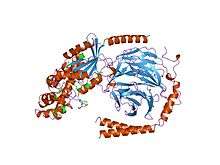GNB4
| GNB4 | |||||||||||||||||
|---|---|---|---|---|---|---|---|---|---|---|---|---|---|---|---|---|---|
 |
|||||||||||||||||
| Identifiers | |||||||||||||||||
| Aliases | GNB4, CMTD1F, G protein subunit beta 4 | ||||||||||||||||
| External IDs | MGI: 104581 HomoloGene: 69140 GeneCards: GNB4 | ||||||||||||||||
| |||||||||||||||||
| Orthologs | |||||||||||||||||
| Species | Human | Mouse | |||||||||||||||
| Entrez | |||||||||||||||||
| Ensembl | |||||||||||||||||
| UniProt | |||||||||||||||||
| RefSeq (mRNA) | |||||||||||||||||
| RefSeq (protein) | |||||||||||||||||
| Location (UCSC) | Chr 3: 179.4 – 179.45 Mb | Chr 3: 32.58 – 32.62 Mb | |||||||||||||||
| PubMed search | [1] | [2] | |||||||||||||||
| Wikidata | |||||||||||||||||
| View/Edit Human | View/Edit Mouse |
Guanine nucleotide-binding protein subunit beta-4 is a protein that in humans is encoded by the GNB4 gene.[3][4][5]
Heterotrimeric guanine nucleotide-binding proteins (G proteins), which integrate signals between receptors and effector proteins, are composed of an alpha, a beta, and a gamma subunit. These subunits are encoded by families of related genes. This gene encodes a beta subunit. Beta subunits are important regulators of alpha subunits, as well as of certain signal transduction receptors and effectors.[5]
References
- ↑ "Human PubMed Reference:".
- ↑ "Mouse PubMed Reference:".
- ↑ Downes GB, Gautam N (Mar 2000). "The G protein subunit gene families". Genomics. 62 (3): 544–52. doi:10.1006/geno.1999.5992. PMID 10644457.
- ↑ Ruiz-Velasco V, Ikeda SR, Puhl HL (Feb 2002). "Cloning, tissue distribution, and functional expression of the human G protein beta 4-subunit". Physiol Genomics. 8 (1): 41–50. doi:10.1152/physiolgenomics.00085.2001. PMID 11842130.
- 1 2 "Entrez Gene: GNB4 guanine nucleotide binding protein (G protein), beta polypeptide 4".
Further reading
- Pietruck F, Moritz A, Montemurro M, et al. (1996). "Selectively enhanced cellular signaling by Gi proteins in essential hypertension. G alpha i2, G alpha i3, G beta 1, and G beta 2 are not mutated.". Circ. Res. 79 (5): 974–83. doi:10.1161/01.res.79.5.974. PMID 8888689.
- Asano T, Morishita R, Ueda H, Kato K (1999). "Selective association of G protein beta(4) with gamma(5) and gamma(12) subunits in bovine tissues.". J. Biol. Chem. 274 (30): 21425–9. doi:10.1074/jbc.274.30.21425. PMID 10409705.
- Huang L, Shanker YG, Dubauskaite J, et al. (2000). "Ggamma13 colocalizes with gustducin in taste receptor cells and mediates IP3 responses to bitter denatonium.". Nat. Neurosci. 2 (12): 1055–62. doi:10.1038/15981. PMID 10570481.
- Evanko DS, Thiyagarajan MM, Siderovski DP, Wedegaertner PB (2001). "Gbeta gamma isoforms selectively rescue plasma membrane localization and palmitoylation of mutant Galphas and Galphaq.". J. Biol. Chem. 276 (26): 23945–53. doi:10.1074/jbc.M101154200. PMID 11294873.
- Huang L, Max M, Margolskee RF, et al. (2003). "G protein subunit G gamma 13 is coexpressed with G alpha o, G beta 3, and G beta 4 in retinal ON bipolar cells.". J. Comp. Neurol. 455 (1): 1–10. doi:10.1002/cne.10396. PMID 12454992.
- Strausberg RL, Feingold EA, Grouse LH, et al. (2003). "Generation and initial analysis of more than 15,000 full-length human and mouse cDNA sequences.". Proc. Natl. Acad. Sci. U.S.A. 99 (26): 16899–903. doi:10.1073/pnas.242603899. PMC 139241
 . PMID 12477932.
. PMID 12477932. - Cuello F, Schulze RA, Heemeyer F, et al. (2003). "Activation of heterotrimeric G proteins by a high energy phosphate transfer via nucleoside diphosphate kinase (NDPK) B and Gbeta subunits. Complex formation of NDPK B with Gbeta gamma dimers and phosphorylation of His-266 IN Gbeta.". J. Biol. Chem. 278 (9): 7220–6. doi:10.1074/jbc.M210304200. PMID 12486123.
- Sprague RS, Bowles EA, Olearczyk JJ, et al. (2003). "The role of G protein beta subunits in the release of ATP from human erythrocytes.". J. Physiol. Pharmacol. 53 (4 Pt 1): 667–74. PMID 12512701.
- Rosskopf D, Nikula C, Manthey I, et al. (2003). "The human G protein beta4 subunit: gene structure, expression, Ggamma and effector interaction.". FEBS Lett. 544 (1-3): 27–32. doi:10.1016/S0014-5793(03)00441-1. PMID 12782285.
- Ota T, Suzuki Y, Nishikawa T, et al. (2004). "Complete sequencing and characterization of 21,243 full-length human cDNAs.". Nat. Genet. 36 (1): 40–5. doi:10.1038/ng1285. PMID 14702039.
- Gerhard DS, Wagner L, Feingold EA, et al. (2004). "The status, quality, and expansion of the NIH full-length cDNA project: the Mammalian Gene Collection (MGC).". Genome Res. 14 (10B): 2121–7. doi:10.1101/gr.2596504. PMC 528928
 . PMID 15489334.
. PMID 15489334.
This article is issued from Wikipedia - version of the 5/31/2016. The text is available under the Creative Commons Attribution/Share Alike but additional terms may apply for the media files.










